人教版九年级全册Unit 1 How can we become good learnersPeriod 1(Section A 1a-2d)知识点课件(共14张PPT)
文档属性
| 名称 | 人教版九年级全册Unit 1 How can we become good learnersPeriod 1(Section A 1a-2d)知识点课件(共14张PPT) | 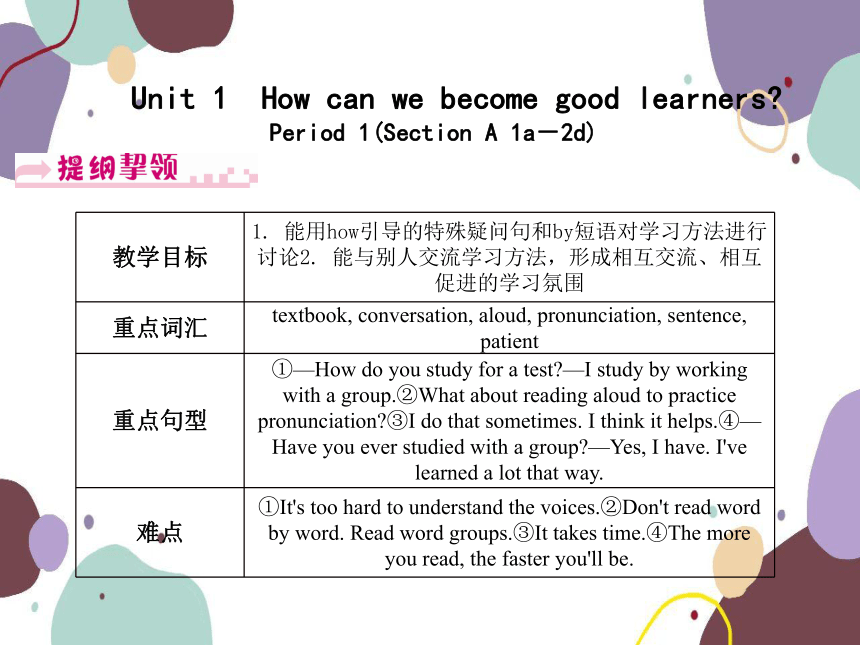 | |
| 格式 | pptx | ||
| 文件大小 | 217.0KB | ||
| 资源类型 | 教案 | ||
| 版本资源 | 人教新目标(Go for it)版 | ||
| 科目 | 英语 | ||
| 更新时间 | 2022-10-15 21:00:07 | ||
图片预览

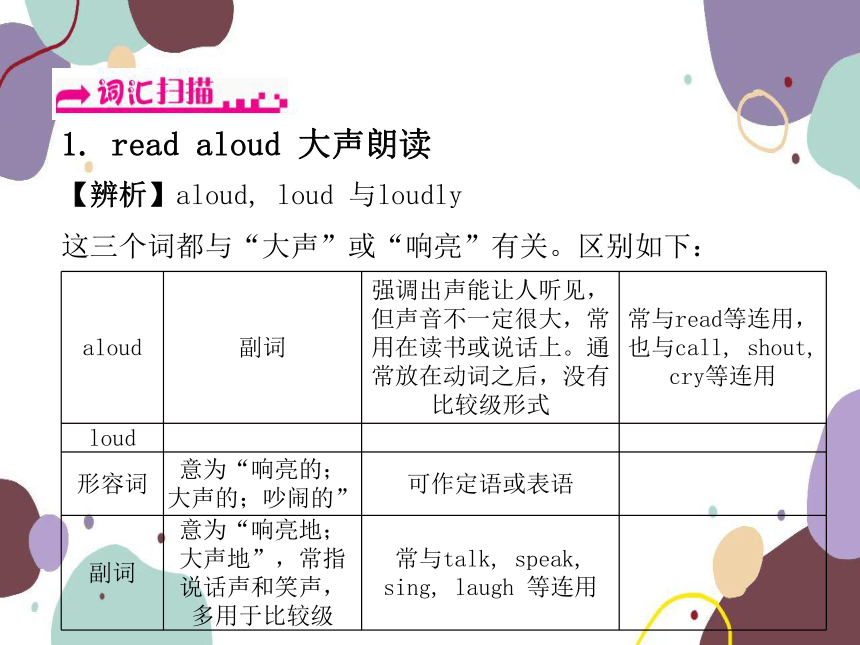
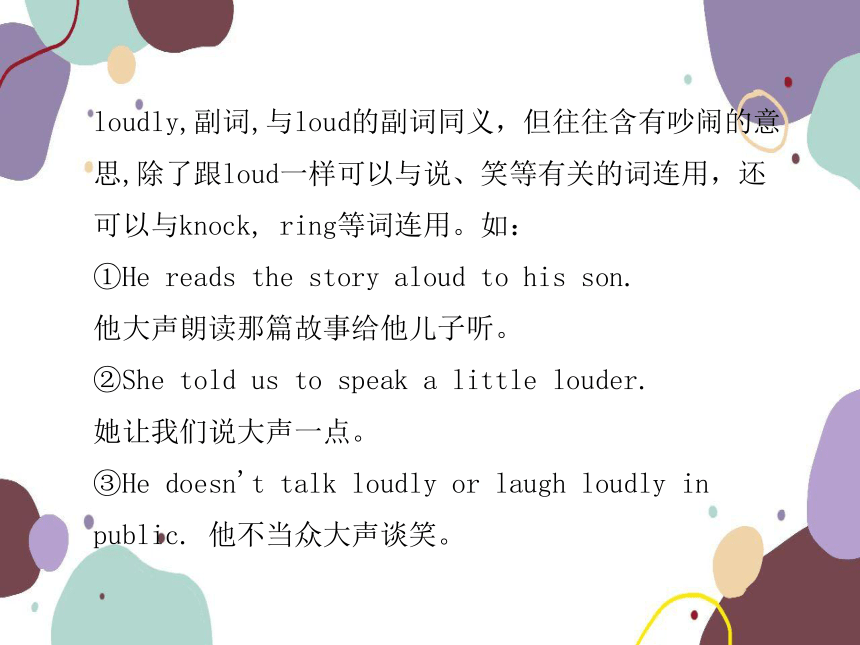
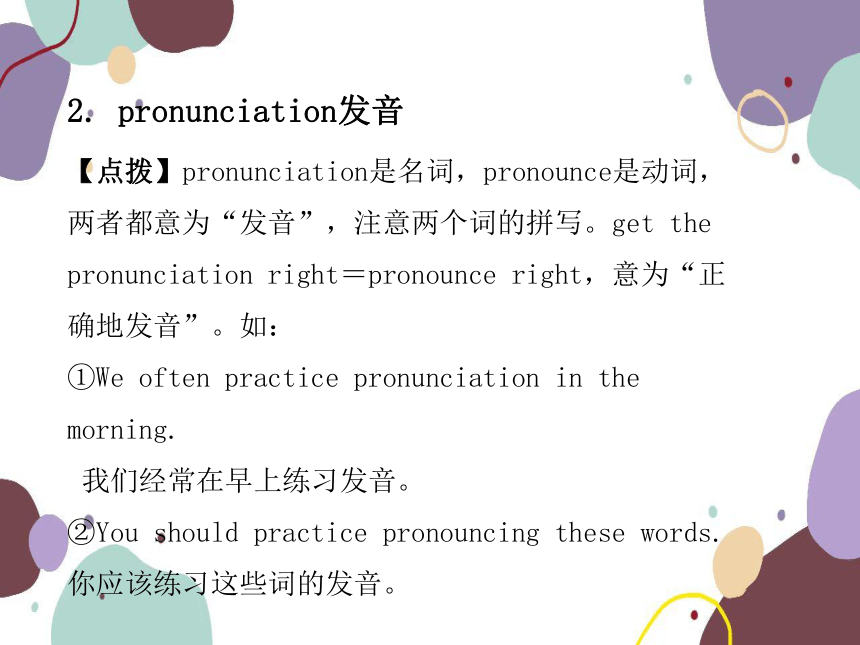
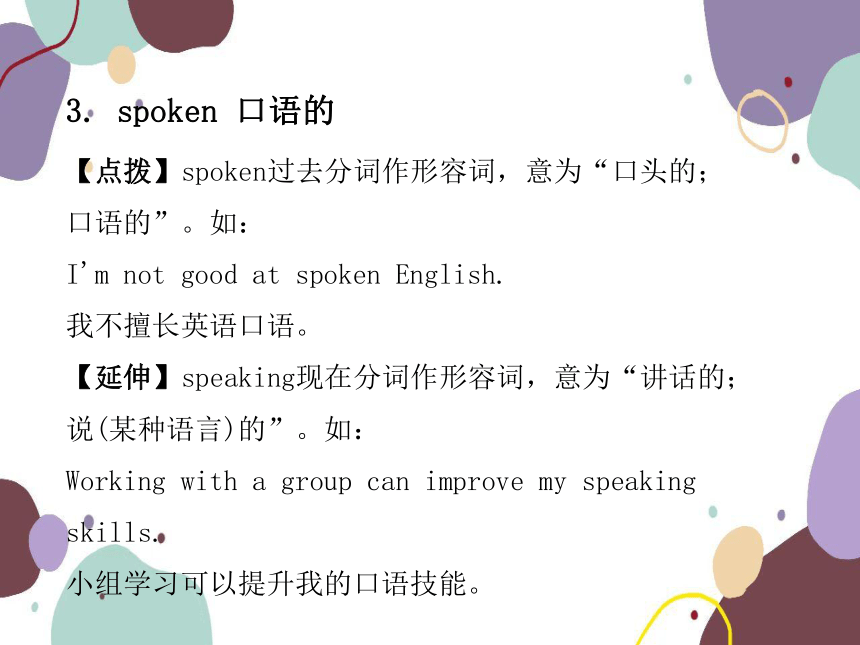
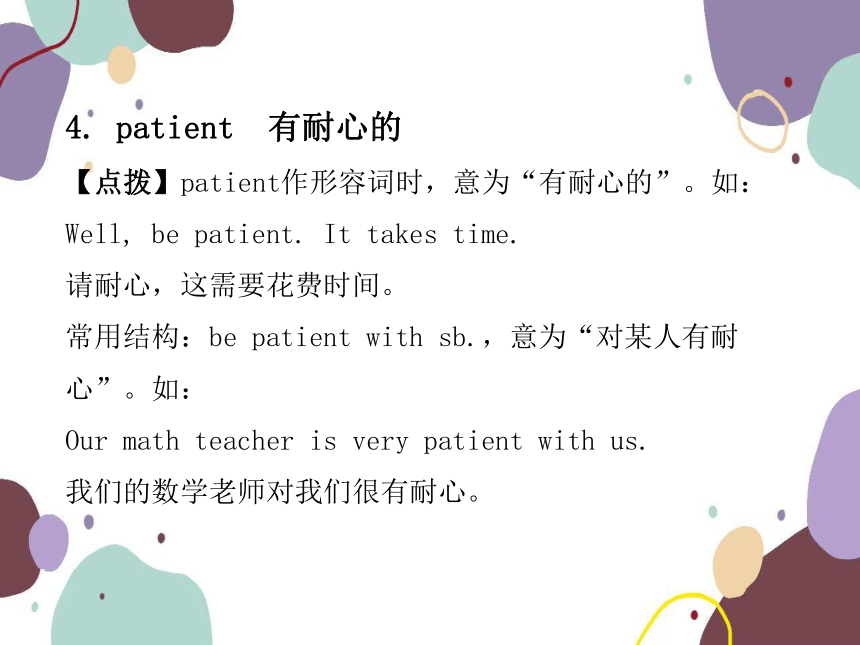
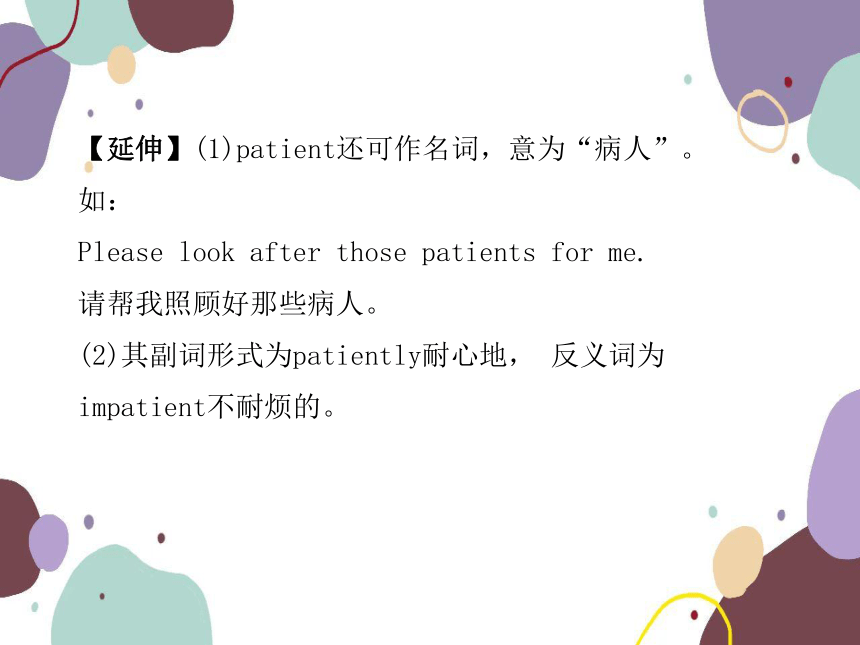
文档简介
(共14张PPT)
Unit 1 How can we become good learners
Period 1(Section A 1a-2d)
教学目标 1. 能用how引导的特殊疑问句和by短语对学习方法进行讨论2. 能与别人交流学习方法,形成相互交流、相互促进的学习氛围
重点词汇 textbook, conversation, aloud, pronunciation, sentence, patient
重点句型 ①—How do you study for a test —I study by working with a group.②What about reading aloud to practice pronunciation ③I do that sometimes. I think it helps.④—Have you ever studied with a group —Yes, I have. I've learned a lot that way.
难点 ①It's too hard to understand the voices.②Don't read word by word. Read word groups.③It takes time.④The more you read, the faster you'll be.
1. read aloud 大声朗读
【辨析】aloud, loud 与loudly
这三个词都与“大声”或“响亮”有关。区别如下:
aloud 副词 强调出声能让人听见,但声音不一定很大,常用在读书或说话上。通常放在动词之后,没有比较级形式 常与read等连用,也与call, shout, cry等连用
loud
形容词 意为“响亮的;大声的;吵闹的” 可作定语或表语
副词 意为“响亮地;大声地”,常指说话声和笑声,多用于比较级 常与talk, speak, sing, laugh 等连用
loudly,副词,与loud的副词同义,但往往含有吵闹的意思,除了跟loud一样可以与说、笑等有关的词连用,还可以与knock, ring等词连用。如:
①He reads the story aloud to his son.
他大声朗读那篇故事给他儿子听。
②She told us to speak a little louder.
她让我们说大声一点。
③He doesn't talk loudly or laugh loudly in public. 他不当众大声谈笑。
2. pronunciation发音
【点拨】pronunciation是名词,pronounce是动词,两者都意为“发音”,注意两个词的拼写。get the pronunciation right=pronounce right,意为“正确地发音”。如:
①We often practice pronunciation in the morning.
我们经常在早上练习发音。
②You should practice pronouncing these words.
你应该练习这些词的发音。
3. spoken 口语的
【点拨】spoken过去分词作形容词,意为“口头的;口语的”。如:
I'm not good at spoken English.
我不擅长英语口语。
【延伸】speaking现在分词作形容词,意为“讲话的;说(某种语言)的”。如:
Working with a group can improve my speaking skills.
小组学习可以提升我的口语技能。
4. patient 有耐心的
【点拨】patient作形容词时,意为“有耐心的”。如:
Well, be patient. It takes time.
请耐心,这需要花费时间。
常用结构:be patient with sb.,意为“对某人有耐心”。如:
Our math teacher is very patient with us.
我们的数学老师对我们很有耐心。
【延伸】(1)patient还可作名词,意为“病人”。如:
Please look after those patients for me.
请帮我照顾好那些病人。
(2)其副词形式为patiently耐心地, 反义词为impatient不耐烦的。
1. I study by reading the textbook.
我通过读课本来学习。
【点拨】by是介词,此处表示“通过某种方式”。如:
①I study by making flashcards.
我通过制作抽认卡来学习。
②Many students said they learned by using English.
许多学生说他们通过使用英语来学习。
【延伸】by还有其他多种含义及用法:
(1)表示时间,意为“在……之前;到……为止;不迟于”。如:I must finish the work by 12 o'clock.
我必须在十二点之前完成工作。
(2)表示移动方向,意为“从……经过”。如:
I walked by Lily's house yesterday.
昨天我从莉莉家经过。
(3)表示位置,意为“靠近;在……旁边”。如:
She often walks by the river.
她经常在河边散步。
(4)用于被动语态中,后接动作的执行者,意为“由;被”。如:The bedroom was cleaned by me.
我打扫过卧室了。
(5)by的相关短语:
by the way顺便提一下;
by the end of到……时为止;
by mistake错误地;
by accident偶然地;
by oneself靠某人自己;
by now到目前为止;
by bike骑自行车
2. Don't read word by word. Read word groups.
不要一个字一个字地读,要按意群读。
【点拨】此句中的介词by表示反复或者连续,意为“一个接着一个;一个又一个”。如:
one by one 一个接一个;day by day 一天又一天;little by little 一点一点地;step by step 一步一步地;year by year 一年又一年
3. It takes time. 这得慢慢来。
【点拨】(1)动词take表示“花费;消耗(时间)”,常用于句式It takes sb. some time to do sth. ,意为“某人花费多少时间做某事”。如:
It takes me half an hour to go to school by bus every day.
我每天花半个小时乘公交车上学。
(2)It takes time.也可说成Please take your time.,表示“不着急;慢慢来”。
4. The more you read, the faster you'll be.你读得越多,你的阅读速度就会越快。
【点拨】“The+比较级+句子, the+比较级+句子”表示“越……,就越……”。如:
①The more I learn about Chinese history, the more I enjoy living in China.
我对中国历史了解得越多,就越喜欢住在中国。
②The more carefully you do your homework, the fewer mistakes you will make.
你作业做得越仔细,犯的错误就会越少。
【延伸】“比较级+and+比较级”意为“越来越……”。如:
①The days are getting longer and longer.
白天变得越来越长。
②His stories become more and more popular.
他的故事变得越来越受欢迎。
Unit 1 How can we become good learners
Period 1(Section A 1a-2d)
教学目标 1. 能用how引导的特殊疑问句和by短语对学习方法进行讨论2. 能与别人交流学习方法,形成相互交流、相互促进的学习氛围
重点词汇 textbook, conversation, aloud, pronunciation, sentence, patient
重点句型 ①—How do you study for a test —I study by working with a group.②What about reading aloud to practice pronunciation ③I do that sometimes. I think it helps.④—Have you ever studied with a group —Yes, I have. I've learned a lot that way.
难点 ①It's too hard to understand the voices.②Don't read word by word. Read word groups.③It takes time.④The more you read, the faster you'll be.
1. read aloud 大声朗读
【辨析】aloud, loud 与loudly
这三个词都与“大声”或“响亮”有关。区别如下:
aloud 副词 强调出声能让人听见,但声音不一定很大,常用在读书或说话上。通常放在动词之后,没有比较级形式 常与read等连用,也与call, shout, cry等连用
loud
形容词 意为“响亮的;大声的;吵闹的” 可作定语或表语
副词 意为“响亮地;大声地”,常指说话声和笑声,多用于比较级 常与talk, speak, sing, laugh 等连用
loudly,副词,与loud的副词同义,但往往含有吵闹的意思,除了跟loud一样可以与说、笑等有关的词连用,还可以与knock, ring等词连用。如:
①He reads the story aloud to his son.
他大声朗读那篇故事给他儿子听。
②She told us to speak a little louder.
她让我们说大声一点。
③He doesn't talk loudly or laugh loudly in public. 他不当众大声谈笑。
2. pronunciation发音
【点拨】pronunciation是名词,pronounce是动词,两者都意为“发音”,注意两个词的拼写。get the pronunciation right=pronounce right,意为“正确地发音”。如:
①We often practice pronunciation in the morning.
我们经常在早上练习发音。
②You should practice pronouncing these words.
你应该练习这些词的发音。
3. spoken 口语的
【点拨】spoken过去分词作形容词,意为“口头的;口语的”。如:
I'm not good at spoken English.
我不擅长英语口语。
【延伸】speaking现在分词作形容词,意为“讲话的;说(某种语言)的”。如:
Working with a group can improve my speaking skills.
小组学习可以提升我的口语技能。
4. patient 有耐心的
【点拨】patient作形容词时,意为“有耐心的”。如:
Well, be patient. It takes time.
请耐心,这需要花费时间。
常用结构:be patient with sb.,意为“对某人有耐心”。如:
Our math teacher is very patient with us.
我们的数学老师对我们很有耐心。
【延伸】(1)patient还可作名词,意为“病人”。如:
Please look after those patients for me.
请帮我照顾好那些病人。
(2)其副词形式为patiently耐心地, 反义词为impatient不耐烦的。
1. I study by reading the textbook.
我通过读课本来学习。
【点拨】by是介词,此处表示“通过某种方式”。如:
①I study by making flashcards.
我通过制作抽认卡来学习。
②Many students said they learned by using English.
许多学生说他们通过使用英语来学习。
【延伸】by还有其他多种含义及用法:
(1)表示时间,意为“在……之前;到……为止;不迟于”。如:I must finish the work by 12 o'clock.
我必须在十二点之前完成工作。
(2)表示移动方向,意为“从……经过”。如:
I walked by Lily's house yesterday.
昨天我从莉莉家经过。
(3)表示位置,意为“靠近;在……旁边”。如:
She often walks by the river.
她经常在河边散步。
(4)用于被动语态中,后接动作的执行者,意为“由;被”。如:The bedroom was cleaned by me.
我打扫过卧室了。
(5)by的相关短语:
by the way顺便提一下;
by the end of到……时为止;
by mistake错误地;
by accident偶然地;
by oneself靠某人自己;
by now到目前为止;
by bike骑自行车
2. Don't read word by word. Read word groups.
不要一个字一个字地读,要按意群读。
【点拨】此句中的介词by表示反复或者连续,意为“一个接着一个;一个又一个”。如:
one by one 一个接一个;day by day 一天又一天;little by little 一点一点地;step by step 一步一步地;year by year 一年又一年
3. It takes time. 这得慢慢来。
【点拨】(1)动词take表示“花费;消耗(时间)”,常用于句式It takes sb. some time to do sth. ,意为“某人花费多少时间做某事”。如:
It takes me half an hour to go to school by bus every day.
我每天花半个小时乘公交车上学。
(2)It takes time.也可说成Please take your time.,表示“不着急;慢慢来”。
4. The more you read, the faster you'll be.你读得越多,你的阅读速度就会越快。
【点拨】“The+比较级+句子, the+比较级+句子”表示“越……,就越……”。如:
①The more I learn about Chinese history, the more I enjoy living in China.
我对中国历史了解得越多,就越喜欢住在中国。
②The more carefully you do your homework, the fewer mistakes you will make.
你作业做得越仔细,犯的错误就会越少。
【延伸】“比较级+and+比较级”意为“越来越……”。如:
①The days are getting longer and longer.
白天变得越来越长。
②His stories become more and more popular.
他的故事变得越来越受欢迎。
同课章节目录
- Unit 1 How can we become good learners.
- Section A
- Section B
- Unit 2 I think that mooncakes are delicious!
- Section A
- Section B
- Unit 3 Could you please tell me where the restroom
- Section A
- Section B
- Unit 4 I used to be afraid of the dark.
- Section A
- Section B
- Unit 5 What are the shirts made of?
- Section A
- Section B
- Review of Units 1-5
- Unit 6 When was it invented?
- Section A
- Section B
- Unit 7 Teenagers should be allowed to choose their
- Section A
- Section B
- Unit 8 It must belong to Carla.
- Section A
- Section B
- Unit 9 I like music that I can dance to.
- Section A
- Section B
- Unit 10 You're supposed to shake hands.
- Section A
- Section B
- Review of Units 6-10
- Unit 11 Sad movies make me cry.
- Section A
- Section B
- Unit 12 Life is full of the unexpected
- Section A
- Section B
- Unit 13 We're trying to save the earth!
- Section A
- Section B
- Unit 14 I remember meeting all of you in Grade 7.
- Section A
- Section B
- Review of Units 11-14
